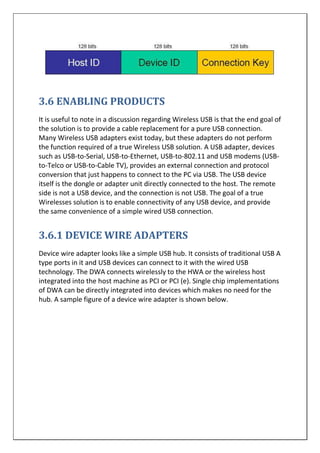The document is a seminar report on Wireless USB presented by Soumyodeep Karmakar. It discusses the key details of Wireless USB including its high-level architecture, radio environment using UWB, WiMedia PHY and MAC layers, topology, power management, and performance capabilities. The report provides an overview of Wireless USB as an evolution of wired USB that enables wireless connectivity while maintaining compatibility and delivering high speeds of up to 480 Mbps initially.









![Position of UWB in protocol stacks
Ultra-Wideband (UWB) may be used to refer to any radio technology having
bandwidth exceeding the lesser of 500 MHz or 20% of the arithmetic center
frequency, according to Federal Communications Commission (FCC). A
February 14, 2002 Report and Order by the FCC [1] authorizes the unlicensed
use of UWB in 3.1– 10.6 GHz. The FCC power spectral density emission limit for
UWB emitters operating in the UWB band is -41.3dBm/MHz. This is the same
limit that applies to unintentional emitters in the UWB band, the so called Part
15 limit. However, the emission limit for UWB emitters can be significantly
lower (as low as-75 dBm/MHz) in other segments of the spectrum.
Deliberations in the International Telecommunication Union Radio
communication Sector (ITU-R) have resulted in a Report and Recommendation
on UWB in November 2005. National jurisdictions around the globe are
expected to act on national regulations for UWB very soon. The UK regulator
Ofcom announced a similar decision [2] on 9 August 2007. Other national
regulatory bodies apparently are somewhat reluctant to allow common
unlicensed use.
The below figure illustrates the position of UWB spectrum in the whole band
used for common radio communications.](https://image.slidesharecdn.com/415e2e60-6ad9-487f-b105-fd3cabbbe257-160220211904/85/Seminar-10-320.jpg)









